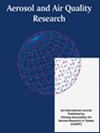An Interactive Clustering-Based Visualization Tool for Air Quality Data Analysis
IF 2.5
4区 环境科学与生态学
Q3 ENVIRONMENTAL SCIENCES
引用次数: 0
Abstract
Examining PM2.5 (atmospheric particulate matter with a maximum diameter of 2.5 micrometers), seasonal patterns is an important research area for environmental scientists. An improved understanding of PM2.5 seasonal patterns can help environmental protection agencies (EPAs) make decisions and develop complex models for controlling the concentration of PM2.5 in different regions. This work proposes an R Shiny App web-based interactive tool, namely a “model-based time series clustering” (MTSC) tool, for clustering PM2.5 time series using spatial and population variables and their temporal features, like seasonality. Our tool allows stakeholders to visualize important characteristics of PM2.5 time series, including temporal patterns and missing values, and cluster series by attribute groupings. We apply the MTSC tool to cluster Taiwan’s PM2.5 time series based on air quality zones and types of monitoring stations. The tool clusters the series into four clusters that reveal several phenomena, including an improvement in Taiwan's air quality since 2017 in all regions, although at varying rates, an increasing pattern of PM2.5 concentration when moving from northern towards southern regions, winter/summer seasonal patterns that are more pronounced in certain types of areas (e.g., industrial), and unusual behavior in the southernmost region. The tool provides cluster-specific quantitative figures, like seasonal variations in PM2.5 concentration in different air quality zones of Taiwan, and identifies, for example, an annual peak in early January and February (maximum value around 120 μg m-3). Our analysis identifies a region in southernmost Taiwan as different from other zones that are currently grouped together with it by Taiwan EPA (TEPA), and a northern region that behaves differently from its TEPA grouping. All these cluster-based insights help EPA experts implement short-term zone-specific air quality policies (e.g., fireworks and traffic regulations, school closures) as well as longer-term decision-making (e.g., transport control stations, fuel permits, old vehicle replacement, fuel type).空气质量数据分析的交互式聚类可视化工具
PM2.5(最大直径为2.5微米的大气颗粒物)的季节变化规律是环境科学家的一个重要研究领域。更好地了解PM2.5的季节变化规律,有助于环境保护部门做出决策,并开发复杂的模型来控制不同地区的PM2.5浓度。本研究提出了一个基于R Shiny App的交互式工具,即“基于模型的时间序列聚类”(MTSC)工具,用于利用空间和人口变量及其时间特征(如季节性)对PM2.5时间序列进行聚类。我们的工具允许利益相关者可视化PM2.5时间序列的重要特征,包括时间模式和缺失值,以及通过属性分组的聚类序列。我们运用MTSC工具,根据空气品质区与监测站类型,对台湾PM2.5时间序列进行聚类。该工具将该系列分为四个集群,揭示了几种现象,包括自2017年以来台湾所有地区的空气质量都有所改善,尽管速度不同,PM2.5浓度从北部向南部地区移动时的增加模式,冬季/夏季季节模式在某些类型的地区(例如工业)更为明显,以及最南部地区的异常行为。该工具提供了特定于集群的定量数据,例如台湾不同空气质量区域PM2.5浓度的季节变化,并确定了例如1月初和2月的年度峰值(最大值约为120 μg m-3)。我们的分析确定了台湾最南端的一个地区与台湾环境保护署(TEPA)目前与之组合在一起的其他地区不同,而北部地区的行为与其TEPA分组不同。所有这些基于集群的见解都有助于EPA专家实施短期特定区域的空气质量政策(例如,烟花和交通法规,学校关闭)以及长期决策(例如,运输控制站,燃料许可,旧车更换,燃料类型)。
本文章由计算机程序翻译,如有差异,请以英文原文为准。
求助全文
约1分钟内获得全文
求助全文
来源期刊

Aerosol and Air Quality Research
ENVIRONMENTAL SCIENCES-
CiteScore
8.30
自引率
10.00%
发文量
163
审稿时长
3 months
期刊介绍:
The international journal of Aerosol and Air Quality Research (AAQR) covers all aspects of aerosol science and technology, atmospheric science and air quality related issues. It encompasses a multi-disciplinary field, including:
- Aerosol, air quality, atmospheric chemistry and global change;
- Air toxics (hazardous air pollutants (HAPs), persistent organic pollutants (POPs)) - Sources, control, transport and fate, human exposure;
- Nanoparticle and nanotechnology;
- Sources, combustion, thermal decomposition, emission, properties, behavior, formation, transport, deposition, measurement and analysis;
- Effects on the environments;
- Air quality and human health;
- Bioaerosols;
- Indoor air quality;
- Energy and air pollution;
- Pollution control technologies;
- Invention and improvement of sampling instruments and technologies;
- Optical/radiative properties and remote sensing;
- Carbon dioxide emission, capture, storage and utilization; novel methods for the reduction of carbon dioxide emission;
- Other topics related to aerosol and air quality.
 求助内容:
求助内容: 应助结果提醒方式:
应助结果提醒方式:


